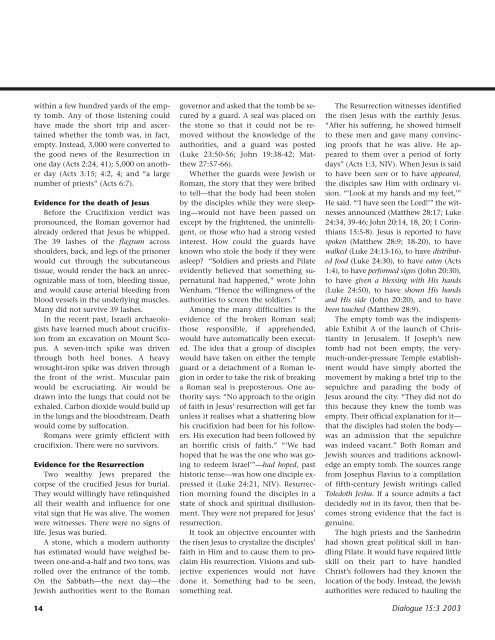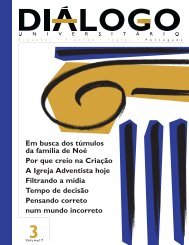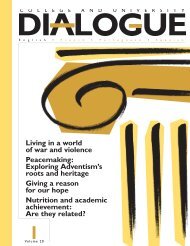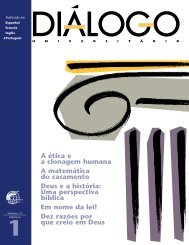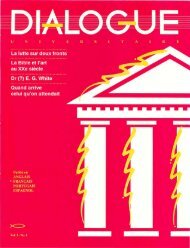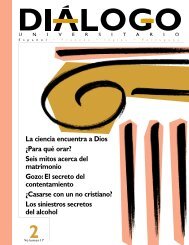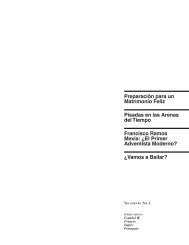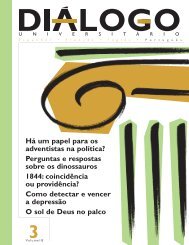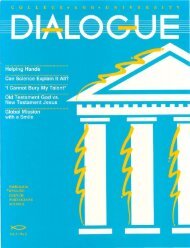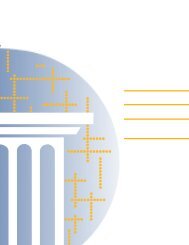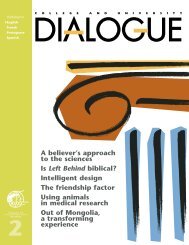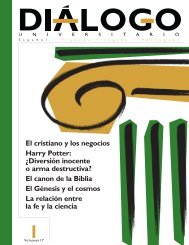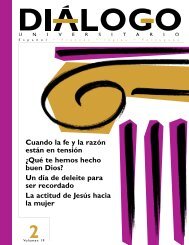Faith, reason, and the educated Christian Creationism - College and ...
Faith, reason, and the educated Christian Creationism - College and ...
Faith, reason, and the educated Christian Creationism - College and ...
You also want an ePaper? Increase the reach of your titles
YUMPU automatically turns print PDFs into web optimized ePapers that Google loves.
within a few hundred yards of <strong>the</strong> empty<br />
tomb. Any of those listening could<br />
have made <strong>the</strong> short trip <strong>and</strong> ascertained<br />
whe<strong>the</strong>r <strong>the</strong> tomb was, in fact,<br />
empty. Instead, 3,000 were converted to<br />
<strong>the</strong> good news of <strong>the</strong> Resurrection in<br />
one day (Acts 2:24, 41); 5,000 on ano<strong>the</strong>r<br />
day (Acts 3:15; 4:2, 4; <strong>and</strong> “a large<br />
number of priests” (Acts 6:7).<br />
Evidence for <strong>the</strong> death of Jesus<br />
Before <strong>the</strong> Crucifixion verdict was<br />
pronounced, <strong>the</strong> Roman governor had<br />
already ordered that Jesus be whipped.<br />
The 39 lashes of <strong>the</strong> flagrum across<br />
shoulders, back, <strong>and</strong> legs of <strong>the</strong> prisoner<br />
would cut through <strong>the</strong> subcutaneous<br />
tissue, would render <strong>the</strong> back an unrecognizable<br />
mass of torn, bleeding tissue,<br />
<strong>and</strong> would cause arterial bleeding from<br />
blood vessels in <strong>the</strong> underlying muscles.<br />
Many did not survive 39 lashes.<br />
In <strong>the</strong> recent past, Israeli archaeologists<br />
have learned much about crucifixion<br />
from an excavation on Mount Scopus.<br />
A seven-inch spike was driven<br />
through both heel bones. A heavy<br />
wrought-iron spike was driven through<br />
<strong>the</strong> front of <strong>the</strong> wrist. Muscular pain<br />
would be excruciating. Air would be<br />
drawn into <strong>the</strong> lungs that could not be<br />
exhaled. Carbon dioxide would build up<br />
in <strong>the</strong> lungs <strong>and</strong> <strong>the</strong> bloodstream. Death<br />
would come by suffocation.<br />
Romans were grimly efficient with<br />
crucifixion. There were no survivors.<br />
Evidence for <strong>the</strong> Resurrection<br />
Two wealthy Jews prepared <strong>the</strong><br />
corpse of <strong>the</strong> crucified Jesus for burial.<br />
They would willingly have relinquished<br />
all <strong>the</strong>ir wealth <strong>and</strong> influence for one<br />
vital sign that He was alive. The women<br />
were witnesses. There were no signs of<br />
life. Jesus was buried.<br />
A stone, which a modern authority<br />
has estimated would have weighed between<br />
one-<strong>and</strong>-a-half <strong>and</strong> two tons, was<br />
rolled over <strong>the</strong> entrance of <strong>the</strong> tomb.<br />
On <strong>the</strong> Sabbath—<strong>the</strong> next day—<strong>the</strong><br />
Jewish authorities went to <strong>the</strong> Roman<br />
governor <strong>and</strong> asked that <strong>the</strong> tomb be secured<br />
by a guard. A seal was placed on<br />
<strong>the</strong> stone so that it could not be removed<br />
without <strong>the</strong> knowledge of <strong>the</strong><br />
authorities, <strong>and</strong> a guard was posted<br />
(Luke 23:50-56; John 19:38-42; Mat<strong>the</strong>w<br />
27:57-66).<br />
Whe<strong>the</strong>r <strong>the</strong> guards were Jewish or<br />
Roman, <strong>the</strong> story that <strong>the</strong>y were bribed<br />
to tell—that <strong>the</strong> body had been stolen<br />
by <strong>the</strong> disciples while <strong>the</strong>y were sleeping—would<br />
not have been passed on<br />
except by <strong>the</strong> frightened, <strong>the</strong> unintelligent,<br />
or those who had a strong vested<br />
interest. How could <strong>the</strong> guards have<br />
known who stole <strong>the</strong> body if <strong>the</strong>y were<br />
asleep? “Soldiers <strong>and</strong> priests <strong>and</strong> Pilate<br />
evidently believed that something supernatural<br />
had happened,” wrote John<br />
Wenham. “Hence <strong>the</strong> willingness of <strong>the</strong><br />
authorities to screen <strong>the</strong> soldiers.”<br />
Among <strong>the</strong> many difficulties is <strong>the</strong><br />
evidence of <strong>the</strong> broken Roman seal;<br />
those responsible, if apprehended,<br />
would have automatically been executed.<br />
The idea that a group of disciples<br />
would have taken on ei<strong>the</strong>r <strong>the</strong> temple<br />
guard or a detachment of a Roman legion<br />
in order to take <strong>the</strong> risk of breaking<br />
a Roman seal is preposterous. One authority<br />
says: “No approach to <strong>the</strong> origin<br />
of faith in Jesus’ resurrection will get far<br />
unless it realises what a shattering blow<br />
his crucifixion had been for his followers.<br />
His execution had been followed by<br />
an horrific crisis of faith.” “‘We had<br />
hoped that he was <strong>the</strong> one who was going<br />
to redeem Israel’”—had hoped, past<br />
historic tense—was how one disciple expressed<br />
it (Luke 24:21, NIV). Resurrection<br />
morning found <strong>the</strong> disciples in a<br />
state of shock <strong>and</strong> spiritual disillusionment.<br />
They were not prepared for Jesus’<br />
resurrection.<br />
It took an objective encounter with<br />
<strong>the</strong> risen Jesus to crystalize <strong>the</strong> disciples’<br />
faith in Him <strong>and</strong> to cause <strong>the</strong>m to proclaim<br />
His resurrection. Visions <strong>and</strong> subjective<br />
experiences would not have<br />
done it. Something had to be seen,<br />
something real.<br />
The Resurrection witnesses identified<br />
<strong>the</strong> risen Jesus with <strong>the</strong> earthly Jesus.<br />
“After his suffering, he showed himself<br />
to <strong>the</strong>se men <strong>and</strong> gave many convincing<br />
proofs that he was alive. He appeared<br />
to <strong>the</strong>m over a period of forty<br />
days” (Acts 1:3, NIV). When Jesus is said<br />
to have been seen or to have appeared,<br />
<strong>the</strong> disciples saw Him with ordinary vision.<br />
“‘Look at my h<strong>and</strong>s <strong>and</strong> my feet,’”<br />
He said. “‘I have seen <strong>the</strong> Lord!’” <strong>the</strong> witnesses<br />
announced (Mat<strong>the</strong>w 28:17; Luke<br />
24:34, 39-46; John 20:14, 18, 20; 1 Corinthians<br />
15:5-8). Jesus is reported to have<br />
spoken (Mat<strong>the</strong>w 28:9; 18-20), to have<br />
walked (Luke 24:13-16), to have distributed<br />
food (Luke 24:30), to have eaten (Acts<br />
1:4), to have performed signs (John 20:30),<br />
to have given a blessing with His h<strong>and</strong>s<br />
(Luke 24:50), to have shown His h<strong>and</strong>s<br />
<strong>and</strong> His side (John 20:20), <strong>and</strong> to have<br />
been touched (Mat<strong>the</strong>w 28:9).<br />
The empty tomb was <strong>the</strong> indispensable<br />
Exhibit A of <strong>the</strong> launch of <strong>Christian</strong>ity<br />
in Jerusalem. If Joseph’s new<br />
tomb had not been empty, <strong>the</strong> verymuch-under-pressure<br />
Temple establishment<br />
would have simply aborted <strong>the</strong><br />
movement by making a brief trip to <strong>the</strong><br />
sepulchre <strong>and</strong> parading <strong>the</strong> body of<br />
Jesus around <strong>the</strong> city. “They did not do<br />
this because <strong>the</strong>y knew <strong>the</strong> tomb was<br />
empty. Their official explanation for it—<br />
that <strong>the</strong> disciples had stolen <strong>the</strong> body—<br />
was an admission that <strong>the</strong> sepulchre<br />
was indeed vacant.” Both Roman <strong>and</strong><br />
Jewish sources <strong>and</strong> traditions acknowledge<br />
an empty tomb. The sources range<br />
from Josephus Flavius to a compilation<br />
of fifth-century Jewish writings called<br />
Toledoth Jeshu. If a source admits a fact<br />
decidedly not in its favor, <strong>the</strong>n that becomes<br />
strong evidence that <strong>the</strong> fact is<br />
genuine.<br />
The high priests <strong>and</strong> <strong>the</strong> Sanhedrin<br />
had shown great political skill in h<strong>and</strong>ling<br />
Pilate. It would have required little<br />
skill on <strong>the</strong>ir part to have h<strong>and</strong>led<br />
Christ’s followers had <strong>the</strong>y known <strong>the</strong><br />
location of <strong>the</strong> body. Instead, <strong>the</strong> Jewish<br />
authorities were reduced to hauling <strong>the</strong><br />
14 Dialogue 15:3 2003


